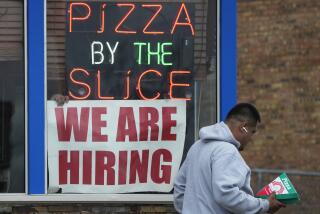Sluggish labor market could muddy Fed debate
WASHINGTON — It was two steps forward, one step back last month for the sluggish labor market.
A modest net gain of 169,000 jobs in August combined with a large downward revision for the previous two months to raise new doubts about whether the economy is strong enough for the Federal Reserve to start dialing back one of its key efforts to boost growth.
Although the unemployment rate ticked down to 7.3% last month — the lowest level since December 2008 — it fell largely for the wrong reason. More discouraged Americans gave up looking for work as the percentage of the population in the labor force dropped for the third consecutive month to its worst point in 35 years.
“The economy is still healing. It’s just not nearly as rapid a growth as we’d like to see,” said economist Daniel Seiver, a finance professor at San Diego State.
At first glance, the Labor Department’s August jobs report wasn’t bad. The top-line number was roughly in line with expectations of 175,000 net new jobs.
But economists digging into the data quickly found discouraging signs that could give Fed policymakers pause when they gather in 10 days to decide whether it’s time to reduce their bond-buying stimulus program.
“The dirt is in the details, and these are very dirty details,” said Diane Swonk, chief economist at Mesirow Financial. “It’s going to muddy the debate about what the Fed does.”
The Labor Department sharply cut the growth figures for June and July by a total of 74,000 jobs. That included resetting July’s level at a paltry 104,000 net new jobs, the economy’s worst performance in more than a year.
The downward revisions meant the average monthly job creation from June through August was 148,000, well below the 184,000 pace over the last 12 months.
“Looking at the revisions was like getting punched in the gut,” Swonk said
Many analysts have been expecting Fed policymakers at their Sept. 17-18 meeting to start gradually reducing the $85 billion in monthly bond purchases, a program that began a year ago to help keep long-term interest rates low.
Whether the Fed will go through with that initial cutback, though, is now a “flip of the coin,” Swonk said.
If the Fed doesn’t act, it could halt the rise in interest rates that’s taken place since the Fed first signaled in May that it was ready to act this year, said Sung Won Sohn, an economics professor at Cal State Channel Islands in Camarillo.
But a delay also could trigger volatility in financial markets as investors grapple with more uncertainty about the Fed’s timetable.
Sohn predicted that the Fed would wait until job growth has averaged 200,000 over three months.
“The economy is in a pretty delicate position,” he said. “There is no reason why the tapering has to start in September.”
Fed officials have said they would closely analyze the incoming economic data, particularly concerning the labor market, before deciding when to act.
With Friday’s jobs report, the recent data have been mixed.
Private reports have shown auto sales were strong in August and growth accelerated last month in the manufacturing and service sectors. But the housing market has shown signs of slowing amid higher mortgage rates, triggered by the expected reduction in Fed bond-buying.
Still, the labor market has improved significantly since the Fed began buying Treasury bonds and mortgage-backed securities to spur the lackluster recovery from the Great Recession.
The unemployment rate was 8.1% when the program started. Fed Chairman Ben S. Bernanke has said the goal was to start reducing the purchases this year and to stop the program completely when the unemployment rate was down to 7%.
Bernanke cautioned that Fed officials would look closely at the unemployment rate to make sure it fairly represented the state of the labor market.
He and other Fed policymakers also have said labor force participation would be a key, and that number has been falling. It dropped a tenth of a percentage point to 63.2% in August, the lowest level since 1978. It was 66% before the recession began in 2007.
“It’s very important to recognize that once again the decline in unemployment did not come the way you want it to — by more people getting jobs. It came by more people giving up the search and leaving the labor market,” said Jared Bernstein, senior fellow at the Center on Budget and Policy Priorities.
But Stuart Hoffman, chief economist at PNC Bank, said August job numbers typically are revised up. The initial number has increased an average of 56,000 over the last four years, according to the Labor Department.
Although August’s numbers were not great, Hoffman said, they weren’t weak. Two key gauges — average hourly earnings and the average workweek — increased, giving workers more income.
The private sector added 152,000 jobs in August, up from the revised 127,000 the previous month, the Labor Department said. Manufacturing rebounded, adding 14,000 jobs last month after shedding 16,000 in July.
And governments added 17,000 jobs in August after dropping 23,000 the previous month.
But retail-sector job creation dropped to 44,000 last month from 48,800 in July. The movie and recording industries lost 22,000 jobs in August after gaining 8,000 the previous month.
Based on all the recent data, Hoffman thinks that the Fed will act soon to reduce its bond-buying.
“I think it’s a matter of when, not if,” Hoffman said. “Whether it’s in two weeks or eight weeks, in the grand scheme of things, it doesn’t matter.”
But Bernstein said the Fed should wait to avoid causing additional problems for an economy that is still having trouble creating enough jobs.
“The labor market remains stuck in second gear,” Bernstein said. “And the last thing you want to try to be doing in second gear is drive up a hill.”







